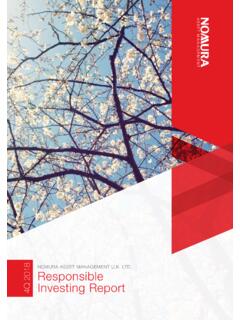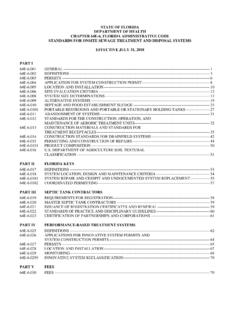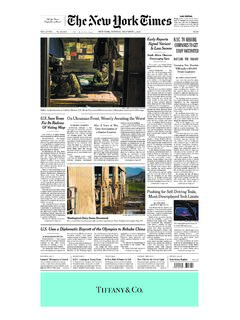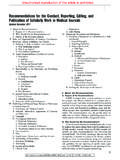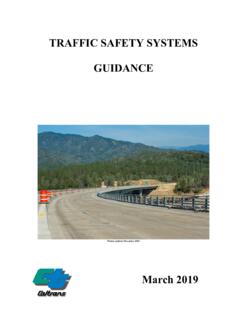Transcription of The Net Stable Funding Ratio (NSFR) What this means for …
1 December 2014 The Net Stable Funding Ratio (NSFR) what this means for you1 | The Net Stable Funding Ratio (NSFR)The information contained in this presentation is not regulatory advice and should not be viewed or relied upon as such. You should seek suitable expert legal or other guidance before placing any reliance upon concept of liquidity supervision is the driving force behind Basel 3 introducing the following 2 key liquidity measures: The Liquidity Coverage Ratio (LCR) requires banks to hold sufficient high-quality liquid assets to cover its total net cash outflows over 30 days. The Net Stable Funding Ratio (NSFR) will require the available amount of Stable Funding to exceed the required amount of Stable Funding for a one-year period of extended LCR has been adopted; the NSFR final standard has been published, it is now in its observation period. ObjectiveTo establish a minimum acceptable amount of Stable Funding based on the liquidity characteristics of an institution s assets and activities over a one year for NSFRJan 2014 Oct 2014 Observation Period1 Jan 2018 Implementation2009 NSFR rstpublishedIncluded inBasel IIIF inalDraftDraft consultativedocument on NSFRC onsultation Period2010 what is NSFR?
2 The NSFR is defined as the amount of available Stable Funding (ASF) relative to the amount of required Stable Funding (RSF). The ASF is defined as the portion of capital and liabilities expected to be reliable over the time horizon considered by the NSFR, which extends to one = ASF (Available Stable Funding ) 100% RSF (Required Stable Funding )ASF amount (see Appendix 1): calculated by multiplying capital and liability category by ASF factor RSF amount (see Appendix 2): calulated by multiplying eash asset category by RSF factorThe information contained in this presentation is not regulatory advice and should not be viewed or relied upon as such. You should seek suitable expert legal or other guidance before placing any reliance upon Net Stable Funding Ratio (NSFR) | 2 The Basel Committee on Banking Supervision (BCBS) published a consultative document on NFSR on 12 Jan 2014, as a revision to the draft published in 2010. A final version of the NSFR was released on 31 October 2014.
3 BCBS intends to implement NSFR as a minimum standard by 1 Jan 2018. The Basel III liquidity measures look to address concerns raised during the the previous crisis, where financial institutions suffered from: Relatively high reliance on wholesale Funding . Holding large amounts of short term Non HQLA assets (short term mismatched book, margin loans, derivative trading asset, etc.).In this document, we look to explain the possible implications for capital level impact Banks fuel economic growth by providing the majority of financing for businesses and consumers. Maturity transformation is one of the key ways in which this business is made viable. However to maintain this business going forward banks will need to: more on retail deposits (an expensive solution).Reduce activity that is high in debt or securely fund themselves with a maturity of 1 year or greater. The revised NSFR treats Equities and Securities Lending Transactions (SFTs) in a conservative manner. It uses the same calibration as the Liquidity Coverage Ratio .
4 A few key RSF ratios are presented below:5%Unencumbered Level 1 assets15%Unencumbered Level 2A assets50%Unencumbered Level 2B assets including HQLA eligible activities85%Physical traded commodities including gold plus all other equities100%All Assets that are encumbered for a period > = 1year or more* For all ratios please refer to appendix 2In assessing SFT with Equities, the NSFR seems to ignores the vital role secondary markets play in | The Net Stable Funding Ratio (NSFR)The information contained in this presentation is not regulatory advice and should not be viewed or relied upon as such. You should seek suitable expert legal or other guidance before placing any reliance upon it. Assets: In the final draft, Basel will continue to apply a 50% RSF factor for level 2B eligible HQLA (85% for all other Equity) inventory positions. This RSF factor for Equity is higher than both the haircut in the secured Funding market and most internal bank stress metrics. Fundamentally, NSFR does not recognise any value of wholesale Funding (such as Debt and Bank loans) maturing less than 1 year.
5 Liabilities: The finalised draft brings in to line the controversial RSF factors for reverse repos. The asymmetrical treatment of short term (below 6 months) reverse repos with non-bank financials, is now lowered from 50% RSF to 10% for Level 1 collateral and 15% for other collateral. However, the Basel Committee eliminates the carve-out for SFT with bank counterparties. As a result, the RSF of SFT to banks shifts from 0% RSF to 10% for Level 1 collateral and to 15% for other collateral. Derivatives: The Asset side will be subject to 100% RSF minus the total collateral posted as variation margin, whereas a derivative liability side will be subject to 100% RSF for 20% of the liability. Initial Margin Treatment is assigned 85% RSF, with an exemption when banks act as an agent on behalf of clients, which we perceive as an improvement over previous on costsImpact on LiquidityExecution Costs Wholesale Funding Financing Depot positions Market making activities Reverse Repo (all counterparties) Securities transformation Prime brokerage costs Primary and Secondary market Primary and Secondary market The information contained in this presentation is not regulatory advice and should not be viewed or relied upon as such.
6 You should seek suitable expert legal or other guidance before placing any reliance upon Net Stable Funding Ratio (NSFR) | 4 Detailed Implications of NSFRThe cost of NSFR in its current form will impact banks that traditionally rely on wholesale banking for Funding . This will lead to a challenge in the market for participants and present a headwind to Funding at profitable levels. Consequently, impacting liquidity and potentially adding to further concentration risk, conflicting with other treatment of long portfolios is unchanged, which leaves the RSF at 50% for Level 2B assets and 85% for other exchange traded equities. Moreover, banking financials will have 85% RSF. Higher cost of execution for end clients. Possible retrenchment of banking organisations from the market with their reduced ability to use hedging strategies that have been commonplace for equities. All long level 2B HQLA inventory positions will be subject to 50% RSF (85% RSF for all other equities).
7 The asymmetrical treatment of short term (below 6 months) reverse repos with non-bank financials is now lowered from RSF 50% to 10% for Level 1 collateral and 15% for other final NSFR standard acknowledges the interdependence of assets and liabilities. However, the treatment of this is left subject to National supervisors interpretation and therefore open to regional bias, whereby, the RSF and ASF may be adjusted to 0% for such transactions. Paragraph 45 of the final document contains stipulations of contractual linkage, equal maturity and the need to have separate counterparties on the asset and liability side. However, National supervisors will have ultimate control over the rule, thus giving the industry some hope for flexibility on the impact of business. The revision treatment of lending/reverse repos with non-banks is a positive step; however, the eliminated carve-out for SFT with bank counterparties was an unanticipated step has a significant potential impact on the cost of doing business from Prime Brokers and consequently the hedge funds.
8 Perversely, this could result in Funding activities drifting away from traditional banking and towards the shadow banking final standard has clarified the NSFR accounting conventions on both the asset and liability side. The convention includes asset purchases not yet settled while excluding asset sales. Therefore, both the asset sale and pending receivable are now included to give the highest possible asset total and by extension, the highest required Funding number or a recent GFMA/IIF, it was agreed that a small group of firms would develop a draft outline that would serve as a starting point for developing a consensus industry view on para 45 (National Interdependence). The draft outline attempted to place transaction in an order of priority and Recommended standard for Paragraph 45 through an implementation | The Net Stable Funding Ratio (NSFR)The information contained in this presentation is not regulatory advice and should not be viewed or relied upon as such.
9 You should seek suitable expert legal or other guidance before placing any reliance upon of NSFR impact Fixed Income Securities: RSF does not reflect market haircuts. RSF for government bonds with a Basel II risk weight of zero is 5%, whereas the ECB window haircut ranges from to for AAA to A- bonds, depending on the remaining term to maturity. Reverse/Stock Borrowing: The asymmetrical treatment of short term (below 6 months) reverse repos with non-bank financials, that the associations previously argued against, is now lowered from 50% RSF to 10% for level 1 collateral and 15% for other collateral. This is independent of lending stock to cover shorts or borrowing secured cash vs equities. However, the Basel Committee eliminates the carve-out for SFT with banks. As a result, the RSF of SFT to banks shifts from 0% to 10% for Level 1 collateral and to 15% for other collateral. Equity Swaps: Under the Final NSFR, long hedges against equity swaps could attract RSF factors of 50% or 85% with no parallel recognition of the Funding provided by the equity swap itself.
10 Although interdependence was acknowledged in the new draft, its impact is yet to be determined. Primary Issuance: Underwriting primary issuance will require 50% capital to be allocated against short term holdings. This will increase cost and impact the primary market directly. Index re-balances: due to the treatment of equities, the availability of short term borrow availability over index rebalance events may dry up or become very costly under the information contained in this presentation is not regulatory advice and should not be viewed or relied upon as such. You should seek suitable expert legal or other guidance before placing any reliance upon Net Stable Funding Ratio (NSFR) | 6 Appendix 1 ASF sheetSummary of liability categories and associated ASF factors:ASF FactorComponents of ASF category100% Total regulatory capital (excluding Tier 2 instruments with residual maturity of less than one year). Other capital instruments and liabilities with effective residual maturity of one year or more.

